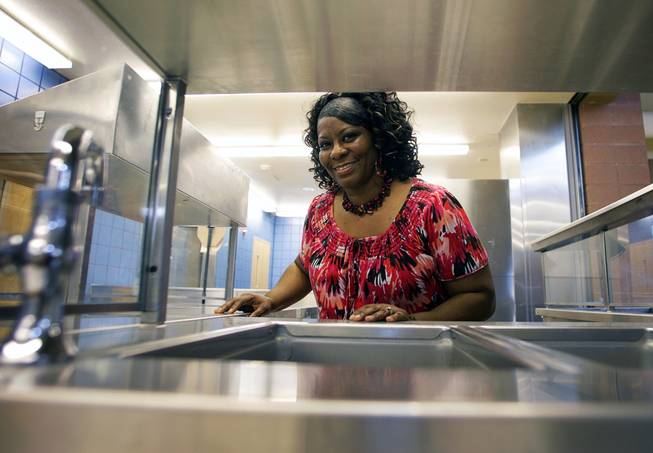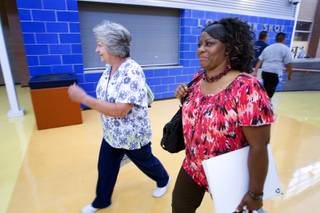
Beverly Davidson, cafeteria manager at Brinley Middle School, poses at Legacy High School after being honored as Northwest Region Cafeteria Manager of the Year Tuesday, August 24, 2010. Davidson has been working for the Clark County School District for 31 years, she said.
Saturday, Aug. 28, 2010 | 2 a.m.
Sun coverage
Beverly Davidson, 53, is a lunch lady. She has prepared, served and supervised meals for students in the Clark County School District since Jimmy Carter was president.
After 31 years, she is one of the longest-serving lunch ladies in the district and may well be the senior lunch lady in Las Vegas.
So let’s get that hairnet thing out of the way.
“I don’t mind the hairnet,” said Davidson, a soft-spoken woman who nonetheless snorts when she hears the question.
“I have had to wear hairnets ever since I’ve been in food service. I think the hairnet is great because I don’t want hair in my food.”
This week, 425 food-service managers, including Davidson, gathered at Legacy High School in North Las Vegas to prepare for Monday’s first day of school.
There are more than 2,000 full-time and substitute food workers for the School District’s 328 elementary, middle and high schools.
Charles Anderson, the district’s director of food services, is a former principal at Gragson Elementary School. His business card includes this, in capital letters, “FUEL FOR STUDENT ACHIEVEMENT.”
In his 14 years at Clark County schools, much has changed with food.
Instead of being cooked from scratch at each school, most food is prepared at a giant central kitchen.
So even though the student population has exploded, tripling to 300,000 hungry mouths over the past 20 years, there are actually fewer food-service workers today, down 20 percent from 2,500, in part because of centralized kitchen operations.
Moreover, the district has had to cook faster to serve more students. The central kitchen can cook, bag and flash-freeze 862 pounds of ground beef for tacos in 1 hour and 20 minutes.
Perhaps the biggest change is the menu, with government mandates to reduce fat, salt and sugar.
“You used to be able to go to a high school cafeteria and get burgers, fries and a milkshake,” Anderson said. “You can’t do that anymore. Now you get teriyaki chicken and corn.”
Vending machines don’t carry candy bars but instead offer baked chips and reduced-fat crackers. Sugary soft drinks are forbidden, with small containers of fruit drinks in their place.
But the district still has some tricks up its sleeve. It makes a special low-fat cinnamon roll that is Agriculture Department-compliant.
“And it’s good and we make 3 million of them a year,” Anderson said.
Davidson also has a trick up her sleeve: She follows the weather report.
Over the years, she has learned that if it’s rainy or windy or cold, students will stay indoors and eat more, especially finger food such as popcorn chicken.
The mother of six children, all grown, Davidson graduated from Chaparral High and attended the forerunner to College of Southern Nevada.
Her first job was at Brinley Middle School, chopping and preparing meals such as ham-and-cheese breakfast sandwiches. After stints at Smith Middle School and Rancho High School, she returned to Brinley, where she is the food-service manager.
One thing that has changed is the number of families that can’t afford school meals, $1.50 for breakfast and $3 for lunch. The district has always offered free or subsidized meals, but now half its students qualify for the program.
“It’s important that every child eats,” Davidson said. “If you don’t eat, you don’t think. You got a full stomach, you’ve got a chance.”
Years ago, when free and subsidized meals were not as widespread, she would notice a child going hungry and find some way to get him on staff.
“You work in the cafeteria,” she said. “You eat for free.”


Join the Discussion:
Check this out for a full explanation of our conversion to the LiveFyre commenting system and instructions on how to sign up for an account.
Full comments policy